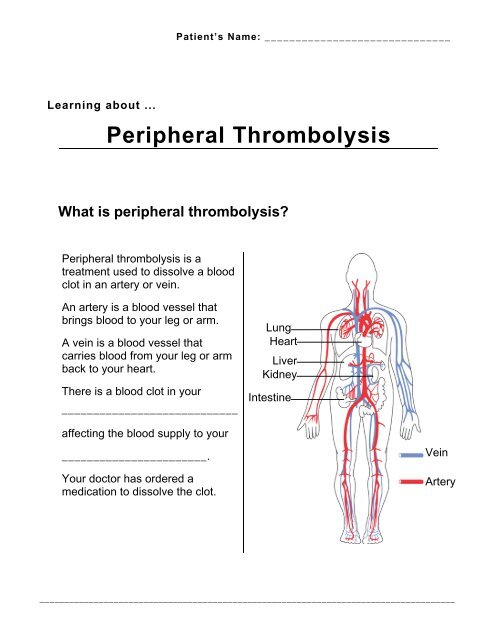Peripheral Thrombolysis - St. Joseph's Healthcare Hamilton
Peripheral Thrombolysis - St. Joseph's Healthcare Hamilton
Peripheral Thrombolysis - St. Joseph's Healthcare Hamilton
Create successful ePaper yourself
Turn your PDF publications into a flip-book with our unique Google optimized e-Paper software.
Patient’s Name: ______________________________<br />
Learning about ...<br />
<strong>Peripheral</strong> <strong>Thrombolysis</strong><br />
What is peripheral thrombolysis?<br />
<strong>Peripheral</strong> thrombolysis is a<br />
treatment used to dissolve a blood<br />
clot in an artery or vein.<br />
An artery is a blood vessel that<br />
brings blood to your leg or arm.<br />
A vein is a blood vessel that<br />
carries blood from your leg or arm<br />
back to your heart.<br />
There is a blood clot in your<br />
____________________________<br />
Lung<br />
Heart<br />
Liver<br />
Kidney<br />
Intestine<br />
affecting the blood supply to your<br />
_______________________.<br />
Your doctor has ordered a<br />
medication to dissolve the clot.<br />
Vein<br />
Artery<br />
____________________________________________________________________________________
2<br />
<strong>Peripheral</strong> <strong>Thrombolysis</strong><br />
How do I get ready for peripheral thrombolysis?<br />
Before your procedure, you will be asked some questions about your:<br />
• past health<br />
• problems with bleeding<br />
• medications<br />
• allergies<br />
You will also have the following done:<br />
• blood tests<br />
• urine tests<br />
• an ECG<br />
• your blood pressure taken<br />
• your heart rate and breathing rate measured<br />
• an intravenous or IV started<br />
• your groin or arm shaved<br />
How is peripheral thrombolysis done?<br />
1. Insertion of the tube:<br />
• The shaved area is cleaned with an antiseptic.<br />
• Your doctor injects a local anesthetic into the skin to “numb” the<br />
shaved area. You will feel a small needle pinch as the doctor<br />
freezes the area.<br />
• A soft narrow tube is placed in your groin or arm. You may feel<br />
some pressure as the doctor inserts the tube.<br />
• With the aid of an x-ray machine, the tube is slowly moved<br />
through the blood vessel until it reaches the clot.<br />
• The doctor injects dye through the tube to see the blood vessel<br />
and the location of the clot.<br />
• The tube is put near the clot. Medication to break up the clot is<br />
given through this tube.<br />
If you have discomfort, you will be given pain<br />
control medication. Tell the doctor or nurse if you feel pain.<br />
__________________________________________________________________________________
<strong>Peripheral</strong> <strong>Thrombolysis</strong><br />
3<br />
2. Delivery of the thrombolysis medication:<br />
• You will go to a nursing unit that specializes in this procedure.<br />
You are given medication through the tube in your groin or arm<br />
for up to 3 days. You stay in the nursing unit for 1 to 2 days after<br />
medication is stopped.<br />
• You are attached to special equipment to monitor your heart and<br />
medications are given intravenously.<br />
• You will feel heat throughout your body when the dye is injected.<br />
• You may feel increased pain in the limb with the clot. This is normal.<br />
Tell the nurse if this happens.<br />
• Your blood pressure, pulses and the area of the tube insertion site<br />
are checked often.<br />
• Your family can visit you in the nursing unit.<br />
Will I be able to eat while I am getting the medication?<br />
You cannot eat solid food. You can have clear fluids while you get<br />
the medication. Some examples of clear fluids include apple juice,<br />
water, gingerale, broth and tea or coffee without milk.<br />
Will I be able to move my leg or arm after the procedure?<br />
You will need to keep your leg or arm straight and lie flat on your back<br />
while the tube is in. You will not be able to bend your knee or elbow.<br />
This is to prevent any movement of the tube.<br />
You will need to call a nurse for a bedpan.<br />
How long will I have the tube in my groin or arm?<br />
Your doctor will decide how long the medication will be given through<br />
the tube.<br />
You will return to the X-ray Department for repeat dye injections through<br />
the tube to see if the medication is breaking down the clot. This will help<br />
the doctor decide how long you will need to get the medication. The usual<br />
time is up to 3 days.<br />
please turn over <br />
____________________________________________________________________________________
4<br />
<strong>Peripheral</strong> <strong>Thrombolysis</strong><br />
Where will the tube be removed?<br />
• The tube will be removed in the nursing unit by the doctor or nurse.<br />
• Pressure will be applied to the puncture site.<br />
• A dressing will then be put on the site.<br />
• You will keep your leg or arm straight and lie flat for 6 to 8 hours.<br />
This promotes healing.<br />
• The nurses will check your blood pressure, pulses and the skin<br />
around the insertion site.<br />
Call your nurse right away if you have any of<br />
these signs:<br />
• bright red blood on the dressing<br />
• a change in the colour or feeling in your arm or leg<br />
• discomfort in your arm, leg or back<br />
• a headache<br />
What happens next?<br />
Other treatments and follow-up appointments will be discussed with you<br />
before you go home.<br />
When will I go home?<br />
Ask you doctor when you can go home.<br />
Arrange to have someone pick you up at 9:00 a.m. the day you leave<br />
the hospital.<br />
© <strong>Hamilton</strong> Health Sciences and<br />
<strong>St</strong>. Joseph’s <strong>Healthcare</strong>, <strong>Hamilton</strong><br />
PD 4450 - 03/2004<br />
dt/March 10, 2004<br />
WPC\PtEduc\LA<strong>Peripheral</strong><strong>Thrombolysis</strong>-trh.doc














